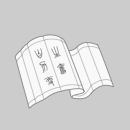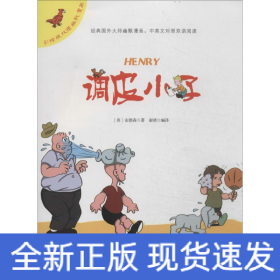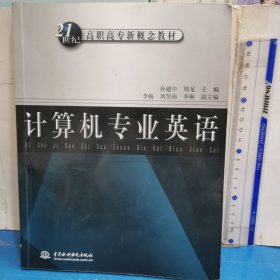
计算机专业英语
全新正版 极速发货
¥ 38.77 6.6折 ¥ 59 全新
库存4件
广东广州
认证卖家担保交易快速发货售后保障
作者戚文静 等
出版社清华大学出版社
ISBN9787302511298
出版时间2019-06
装帧平装
开本16开
定价59元
货号1201873374
上书时间2024-06-06
- 最新上架
商品详情
- 品相描述:全新
- 商品描述
-
目录
Chapter1 Introduction of Computer Science1
1.1 History of Computer Science1
1.2 Areas of Computer Science4
1.2.1 Theoretical Computer Science4
1.2.2 Applied Computer Science6
1.3 Is Computer Science Science?7
1.3.1 Common Understandings of Science7
1.3.2 Internal Disagreement10
1.3.3 Computer Science Thrives on Relationships10
1.3.4 Validating Computer Science Claims11
1.4 The Future of Computer Science12
1.4.1 Introduction12
1.4.2 Innovative Research Projects14
1.4.3 Theoretical Foundation17
1.4.4 An Interview18
1.5 Key Terms and Review Questions22
References25
Chapter2 Computer Architecture and Networks27
2.1 Introduction27
2.1.1 Computer Architecture27
2.1.2 Design Goals28
2.2 Computer System29
2.2.1 Hardware29
2.2.2 Software31
2.3 Computer Networking33
2.3.1 Network Hardware34
2.3.2 Network Protocols35
2.3.3 Internet and TCP/IP37
2.4 Wireless Network40
2.4.1 Wireless LAN Networking Basics40
2.4.2 Mobile Network41
2.4.3 Wireless Sensor Network42
2.5 Key Terms and Review Questions46
References51
Chapter3 Operating System52
3.1 Definition and Function52
3.1.1 What is Operating System?52
3.1.2 Functions of Operating System53
3.1.3 Types of Operating Systems55
3.2 Tasks of an Operating System57
3.2.1 Processor Management57
3.2.2 Process Management59
3.2.3 Memory and Storage Management60
3.2.4 Device Management61
3.2.5 Application Interface62
3.2.6 User Interface63
3.3 Examples of Popular Modern Operating Systems65
3.3.1 UNIX and UNIX-like Operating Systems65
3.3.2 Microsoft Windows67
3.4 Comparison of Windows and UNIX Environments69
3.5 Key Terms and Review Questions82
References84
Chapter4 Algorithms, Data Structures and Software Engineering86
4.1 Algorithm86
4.1.1 Introduction86
4.1.2 Definition of Algorithms87
4.1.3 Specifying Algorithms89
4.1.4 Examples — Sorting Algorithms90
4.1.5 Algorithm Analysis98
4.2 Data Structures100
4.2.1 Definition100
4.2.2 Types of Data Structure102
4.3 Programming106
4.3.1 Evolution of Programming Language106
4.3.2 Basic Components and Structure of a Program107
4.3.3 Object-oriented Programming112
4.4 Software Engineering116
4.4.1 Life Cycle of Software116
4.4.2 Software Development Models118
4.4.3 Software Quality Characteristics121
4.5 Key Terms and Review Questions123
References127
Chapter 5 Databases and Information Retrieval129
5.1 Database System129
5.1.1 Database129
5.1.2 Relational Database130
5.1.3 Database Management System133
5.1.4 SQL135
5.2 Information Retrieval136
5.2.1 Introduction136
5.2.2 An Example of Information Retrieval138
5.2.3 Open Source IR System143
5.2.4 Performance Measure144
5.3 Web Search Basics145
5.3.1 Background and History145
5.3.2 Web Search Features147
5.3.3 Web Crawling and Indexes150
5.4 Key Terms and Review Questions152
References155
Chapter 6 Artifi Intelligence156
6.1 Introduction156
6.1.1 History of AI156
6.1.2 Research Branches of AI157
6.2 Turing Test161
6.2.1 Introduction161
6.2.2 Alan Turing161
6.2.3 Inception of the Turing Test162
6.2.4 Problems/Difficulties with the Turing Test163
6.2.5 The Current State of the Turing Test165
6.2.6 Artifi Intelligence Computer System Passes Visual Turing Test166
6.3 Knowledge Representation and Reasoning168
6.3.1 How to Represent Knowledge168
6.3.2 Representation169
6.3.3 Reasoning about Knowledge170
6.3.4 KBS170
6.3.5 MYCIN—A Case Study172
6.4 Case-based Reasoning173
6.4.1 Introduction173
6.4.2 Fundamental of Case-based Reasoning174
6.4.3 The CBR Process175
6.4.4 Example-based Machine Translation177
6.5 Robotics180
6.5.1 Components of Robot180
6.5.2 Control System184
6.5.3 Environmental Interaction and Navigation185
6.5.4 Top 10 Humanoid Robots187
6.6 Computer Vision192
6.6.1 Brief Introduction192
6.6.2 Tasks of Computer Vision194
6.6.3 An Example — Fa Recognition System196
6.7 Existential Risk from Artifi General Intelligence198
6.7.1 Overview198
6.7.2 Risk Scenarios199
6.7.3 Different Reactions on the Thesis203
6.8 Key Terms and Review Questions204
References208
Chapter 7 Computer Graphics and Visualization210
7.1 Computer Graphics210
7.1.1 What Is Computer Graphics210
7.1.2 Types of Graphics211
7.1.3 Techniques Used in CG214
7.1.4 Computer-aided Design217
7.1.5 3D Modeling219
7.2 Virtual Reality221
7.2.1 What Is Virtual Reality?222
7.2.2 Types of Virtual Reality223
7.2.3 Equipment Used in Virtual Reality225
7.2.4 Applications of Virtual Reality227
7.2.5 Pros and Cons of Virtual Reality228
7.3 Data Visualization229
7.3.1 Characteristics of Effective Graphical Displays230
7.3.2 Quantitative Messages230
7.3.3 Visual Perception and Data Visualization231
7.3.4 Examples of Diagrams Used for Data Visualization232
7.4 Key Terms and Review Questions237
References240
Chapter 8 Human-Computer Interaction241
8.1 Human-Computer Interaction241
8.1.1 History of HCI241
8.1.2 From Cabal to Community242
8.1.3 Beyond the Desktop243
8.1.4 The Task-artifact Cycle245
8.1.5 A Caldron of Theory246
8.1.6 Implications of HCI for Science, Practice, and Epistemology247
8.2 User Interface Design Adaptation248
8.2.1 Introduction248
8.2.2 User Interface/Task/Platform Relations251
8.2.3 Authoring Multi-Device Interactive Applications251
8.2.4 Adaptation Rules252
8.2.5 Model-based UI Design in Multi-Device Contexts254
8.2.6 Vocal Interfaces256
8.2.7 Multimodal User Interfaces256
8.3 HRI258
8.3.1 Introduction of HRI258
8.3.2 HRI — About (not) Romanticizing Robots260
8.3.3 HRI — There Is No Such Thing as “Natural Interaction”261
8.3.4 HRI — There Is a Place For Non-humanoid Robots263
8.4 Key Terms and Review Questions265
References267
Chapter 9 Computer Security269
9.1 Computer Security Issues269
9.1.1 Basic Security Concepts269
9.1.2 Threats and Attacks271
9.1.3 A Model for Network Security275
9.2 Security Countermeasure277
9.3 Cryptography282
9.3.1 Basic Concepts283
9.3.2 History of Cryptography283
9.3.3 Modern Cryptography287
9.4 Top 10 Cyber-security Issues in 2016290
9.5 Cyberwar292
9.5.1 A Cybersecurity Wargame Scenario292
9.5.2 The First Casualty of Cyberwar Is The Web293
9.5.3 Building Digital Armies294
9.5.4 How Cyber Weapons Work296
9.5.5 When Is a Cyberwar Not a Cyberwar?297
9.5.6 The Targets in Cyberwar298
9.5.7 Cyberwar: Coming to a Living Room Near You?298
9.6 Key Terms and Review Questions299
References303
Chapter 10 Latest Progresses in Computer Science304
10.1 Quantum Information Science304
10.1.1 Quantum Computing304
10.1.2 Quantum Cryptography308
10.2 Deep Learning311
10.2.1 Introduction311
10.2.2 Historical Trends in Deep Learning315
10.3 Cloud Computing319
10.3.1 The Vision of Cloud Computing320
10.3.2 Defining a Cloud322
10.3.3 A Closer Look323
10.3.4 The Cloud Computing Reference Model325
10.4 Big Data326
10.4.1 Let the Data Speak326
10.4.2 Definition and Characteristic of Big Data329
10.4.3 Value of Big Data330
10.4.4 Risk of Big Data332
10.5 Key Terms and Review Questions333
References337
内容摘要
本书从计算机科学各个领域的很新教材、专著、论文、百科等英文素材中选择各分支学科的基本概念、方法及很新发展等内容,涵盖计算机硬件、软件、数据库、网络、信息安全、人工智能、机器学习、人机交互、量子计算、大数据、云计算等领域的基础理论和应用,内容具有基础性、趣味性、广泛性和知识性。读者通过阅读和学习本书,能够掌握大量的英文专业术语、熟悉常用的语法和句式表达方法,提高读者在计算机科学相关领域的英语应用能力。同时本书精心选择的内容还可帮助读者丰富计算机学科知识、拓展科学研究视野。
本书可作为普通高等学校计算机科学与技术、网络工程、软件工程及相关专业的英语教材或计算机导论课程的双语教材,也可作为从事相关行业的科研与工程技术人员的参考用书。
主编推荐
精彩内容
相关推荐
— 没有更多了 —






















以下为对购买帮助不大的评价